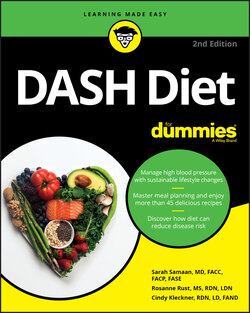Читать книгу DASH Diet For Dummies - Sarah Samaan - Страница 36
Omni-Heart: A Variation on the DASH Theme
ОглавлениеIn 2003, a group of researchers from Johns Hopkins University and Harvard University decided to test the theory that by increasing high-quality protein, and slightly decreasing carbohydrates, the DASH diet could be made even better. Funded by the National Institutes of Health, the Optimal Macronutrient Intake Trial to Prevent Heart Disease — also known as Omni-Heart — included 164 individuals similar to those enrolled in DASH. The average age was 54, 45 percent were women, and 55 percent were black. Most were overweight or obese. Everyone’s blood pressure was at least 120/80 at baseline.
Three different diets were tested:
The carbohydrate diet was very similar to DASH, except that it was a little heavier in carbs and a bit lighter in protein. (Carbohydrates made up more than 55 percent of the calories in the original DASH diet; protein made up 18 percent.)
The protein diet had 25 percent of calories coming from protein, about half of which were of plant origin (think soy, beans, and nuts). Carbs were cut to 48 percent, as compared to 58 percent in the DASH-like carb diet.
The unsaturated fat diet provided 37 percent of its calories from fat (compared with 27 percent in the other two options), more than half of which was monounsaturated (typical sources include olive oil, canola oil, peanut oil, avocado oil, avocados, and almonds). Protein content was the same as in the DASH-type diet, while carbs were kept to 48 percent.
To put it more simply, the Omni-Heart researchers played with just 10 percent of the DASH diet calories, boosting protein in the protein diet and bumping up monounsaturated fat in the unsaturated fat diet, both at the expense of carbohydrates. Omni-Heart wasn’t a low-sodium study. Everyone received the same amounts of sodium (a middle-of-the-road 2,300 milligrams) and similar amounts of blood pressure–friendly potassium, magnesium, and calcium. Omni-Heart wasn’t a weight loss diet, so calories were kept constant to maintain a stable body weight.
Much like in the original DASH study, Omni-Heart researchers prepared all the food for participants. Each person spent about six weeks on each of the three diets, with the sequence of the diets (carb versus protein versus mono-fat) randomly assigned.
Compared with baseline blood pressure readings, blood pressures improved on each of the three diets. However, both the diet higher in protein and the one with more monounsaturated fat had a significantly greater impact on blood pressure control for those people who already had high blood pressure. To be more precise, on the DASH-style diet, systolic blood pressure plunged by an impressive 13 points in people with hypertension. Nice! But both the higher protein and the higher monounsaturated fat diets surged ahead with a 16-point drop over baseline. Likewise, diastolic pressure fell by a respectable 6 points in the DASH-like diet but tumbled more than 8 points with the other two options. Lipid numbers (HDL, or “good” cholesterol; LDL, or “bad” cholesterol; and triglycerides) were also somewhat better on both of the alternative diets, although all three options improved LDL cholesterol readings compared to baseline.
The results of Omni-Heart show that by cutting carbs just a bit and adding a small dollop of good fat or high-quality protein, the DASH diet can be enhanced and enriched. More important, these results reveal that you shouldn’t be afraid to reduce grain servings (to 5 to 6 servings) in DASH just a little, as long as you substitute high-quality protein and healthy monounsaturated fats. Healthy food should never be boring. Whether simply made or worthy of a master chef, a good meal is not only sustenance but also one of life’s true and pure pleasures.
